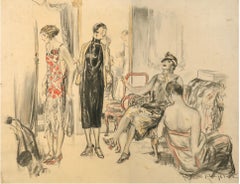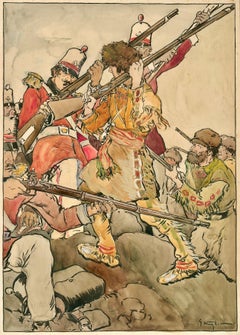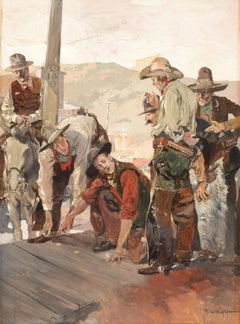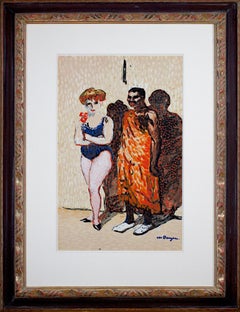George Hand Wright Art
to
4
4
3
1
4
Overall Height
to
Overall Width
to
4
4
2
2
1
1
1
4
2
1
4
6,934
3,277
2,514
1,216
4
4
2
2
1
Artist: George Hand Wright
Young Woman Tries on Gown
By George Hand Wright
Located in Fort Washington, PA
Signed Lower Right by Artist
Magazine story illustration: “Mr. and Mrs. Fixit”, author: Ring Lardner, Liberty Magazine; publisher: (Liberty Weekly, Inc.), Vol. 2, no 1, May 9, 1925.
Category
1920s George Hand Wright Art
Materials
Watercolor, Charcoal
British Soldiers in Combat
By George Hand Wright
Located in Fort Washington, PA
Medium: Ink and Gouache
Signature: Signed Lower Right
Probably a magazine cover for a Munsey’s pulp, ca. 1905.
Category
Early 1900s George Hand Wright Art
Materials
Gouache, Ink
Seats of the Haughty, Munsey's Magazine Illustration
By George Hand Wright
Located in Fort Washington, PA
Medium: Gouache on Board
Signature: Signed Lower Right
Seats of the Haughty, Munsey's Magazine illustration, December 1906
Literature: This illustration appeared in O. Henry's shor...
Category
Early 1900s George Hand Wright Art
Materials
Board, Gouache
Figure in the Forest
By George Hand Wright
Located in Fort Washington, PA
Medium: Watercolor on Board
Dimensions: 23.50" x 15.00"
Signature: Signed Lower Right
Category
20th Century George Hand Wright Art
Materials
Watercolor, Board
Related Items
Belisama
By Oswaldo Vigas
Located in Palm Beach, FL
Predominantly recognized as a self-taught painter, he also worked in architectural murals, sculptures, ceramics, prints and drawings.
Vigas is one...
Category
1960s Cubist George Hand Wright Art
Materials
Canvas, Oil, Gouache, Board
Kees Van Dongen Circus Performers 1900s Vintage Vibrant Figure Fauvist Signed
By Kees van Dongen
Located in Milwaukee, WI
"Les Artistes du Cirque" is an original painting in ink, watercolor, and gouache on paper by leading Fauvist artist Kees Van Dongen, signed in the lower right. In the piece, two circus performers stand against against a wall. On the left, a pale woman in a blue leotard with red flowers on the shoulder stands with her arms crossed, looking out at the viewer. The painter fills in her tights with delicate white brushstrokes, lending them an almost iridescent appearance. Her strawberry blond hair is piled on top of her hair according to the fashion of the period. On the right, an African man stands in a vivid orange toga, looking somewhere off to the left. His feet are clad in bright white shoes...
Category
Early 1900s Fauvist George Hand Wright Art
Materials
Paper, Ink, Watercolor, Gouache
Simka Simkhovitch WPA W/C Painting Gouache American Modernist Beach Scene Nude
By Simka Simkhovitch
Located in Surfside, FL
Simka Simkhovitch (Russian/American 1893 - 1949)
This came with a small grouping from the artist's family, some were hand signed some were not.
These were studies for larger paintings.
This is a watercolor and gouache beach scene three young men bathing...
Category
1930s American Modern George Hand Wright Art
Materials
Watercolor, Gouache, Board
Richard Caton Woodville II (1856 - 1927) 1794 War Balloon Aquarell England 1910
By Richard Caton Woodville Jr.
Located in Meinisberg, CH
Richard Caton Woodville II
(British, 1856 - 1927)
The French Aerostatic Corps - The first War Balloon The launching of the L'Entreprenant used by the French Army under General Jourd...
Category
1910s English School George Hand Wright Art
Materials
Paper, Watercolor, Gouache, Cardboard
Free Shipping
H 15.56 in W 22.25 in D 1.58 in
Summer Fashion. Young Victorian Lady With Meadow Flowers In Her Straw Hat
Located in Sutton Poyntz, Dorset
Alice Anne Renshaw.
English ( b.1849 - d.1900 ).
Young Lady With Meadow Flowers In Her Straw Hat
Watercolor & Gouache on Artist's Board ( An embossed stamp in the top left hand corn...
Category
Late 19th Century Realist George Hand Wright Art
Materials
Watercolor, Gouache, Board
H 29.93 in W 25.6 in D 2.96 in
Life Magazine Art Deco Showgirls Cartoon
Located in Wilton Manors, FL
Barbara Shermund (1899-1978). Showgirls Cartoon for Life Magazine, 1934. Ink, watercolor and gouache on heavy illustration paper, matting window measures 16.5 x 13 inches; sheet measures 19 x 15 inches; Matting panel measures 20 x 23 inches. Signed lower right. Very good condition with discoloration and toning in margins. Unframed.
Provenance: Ethel Maud Mott Herman, artist (1883-1984), West Orange NJ.
For two decades, she drew almost 600 cartoons for The New Yorker with female characters that commented on life with wit, intelligence and irony.
In the mid-1920s, Harold Ross, the founder of a new magazine called The New Yorker, was looking for cartoonists who could create sardonic, highbrow illustrations accompanied by witty captions that would function as social critiques.
He found that talent in Barbara Shermund.
For about two decades, until the 1940s, Shermund helped Ross and his first art editor, Rea Irvin, realize their vision by contributing almost 600 cartoons and sassy captions with a fresh, feminist voice.
Her cartoons commented on life with wit, intelligence and irony, using female characters who critiqued the patriarchy and celebrated speakeasies, cafes, spunky women and leisure. They spoke directly to flapper women of the era who defied convention with a new sense of political, social and economic independence.
“Shermund’s women spoke their minds about sex, marriage and society; smoked cigarettes and drank; and poked fun at everything in an era when it was not common to see young women doing so,” Caitlin A. McGurk wrote in 2020 for the Art Students League.
In one Shermund cartoon, published in The New Yorker in 1928, two forlorn women sit and chat on couches. “Yeah,” one says, “I guess the best thing to do is to just get married and forget about love.”
“While for many, the idea of a New Yorker cartoon conjures a highbrow, dry non sequitur — often more alienating than familiar — Shermund’s cartoons are the antithesis,” wrote McGurk, who is an associate curator and assistant professor at Ohio State University’s Billy Ireland Cartoon Library & Museum. “They are about human nature, relationships, youth and age.” (McGurk is writing a book about Shermund.
And yet by the 1940s and ’50s, as America’s postwar focus shifted to domestic life, Shermund’s feminist voice and cool critique of society fell out of vogue. Her last cartoon appeared in The New Yorker in 1944, and much of her life and career after that remains unclear. No major newspaper wrote about her death in 1978 — The New York Times was on strike then, along with The Daily News and The New York Post — and her ashes sat in a New Jersey funeral home...
Category
1930s Art Deco George Hand Wright Art
Materials
Ink, Gouache
Simka Simkhovitch WPA Artist Oil Painting Gouache American Modernist Powerline
By Simka Simkhovitch
Located in Surfside, FL
Simka Simkhovitch (Russian/American 1893 - 1949)
This came with a small grouping from the artist's family, some were hand signed some were not.
These were studies for larger paintings.
Simka Simkhovitch (Симха Файбусович Симхович) (aka Simka Faibusovich Simkhovich) (Novozybkov, Russia May 21, 1885 O.S./June 2, 1885 N.S.—Greenwich, Connecticut February 25, 1949) was a Ukrainian-Russian Jewish artist and immigrant to the United States. He painted theater scenery in his early career and then had several showings in galleries in New York City. Winning Works Progress Administration (WPA) commissions in the 1930s, he completed murals for the post offices in Jackson, Mississippi and Beaufort, North Carolina. His works are in the permanent collections of the Dallas Museum of Art, the National Museum of American Art and the Whitney Museum of American Art. Born outside Kyiv (Petrograd Ukraine) into a Jewish family who owned a small department store. During a severe case of measles when he was seven, Simcha Simchovitch sketched the views outside his window and decided to become an artist, over his father's objections. Beginning in 1905, he studied at the Grekov Odessa Art School and upon completion of his studies in 1911 received a recommendation to be admitted to the Imperial Academy of Arts. Though he enrolled to begin classes in architecture, painting, and sculpture at the Imperial Academy, he was dropped from the school roster in December because of the quota on the number of Jewish students and drafted into the army. Simchovitch served as a private in the 175th Infantry Regiment Baturyn [ru] until his demobilization in 1912. Re-enrolling in the Imperial Academy, he audited classes.
Simka Simkhovitch exhibited paintings and sculptures in 1918 as part of an exhibition of Jewish artists and in 1919 placed 1st in the competition "The Great Russian Revolution" with a painting called "Russian Revolution" which was hung in the State Museum of Revolution. In 1922, Simkha Simkhovitch exhibited at the International Book Fair in Florence (Italian: Fiera Internazionale del Libro di Firenze). In 1924, Simkhovitch came to the United States to make illustrations for Soviet textbooks and decided to immigrate instead. Initially he supported himself by doing commercial art and a few portrait commissions. In 1927, he was hired to paint a screen for a scene in the play "The Command to Love" by Fritz Gottwald and Rudolph Lothar which was playing at the Longacre Theatre on Broadway. Art dealers began clamoring for the screen and Simkhovitch began a career as a screen painter for the theater. Catching the attention of the screenwriter, Ernest Pascal, he worked as an illustrator for Pascal, who then introduced him to gallery owner, Marie Sterner. Simkhovitch's works appeared at the Marie Sterner Gallery beginning with a 1927 exhibit and were repeated the following year. Simkhovitch had an exhibit in 1929 at Sterner's on circus paintings. In 1931, he held a showing of works at the Helen Hackett Gallery, in New York City and later that same year he was one of the featured artists of a special exhibit in San Francisco at the California Palace of the Legion of Honor in Lincoln Park. The exhibit was coordinated by Marie Sterner and included four watercolors, including one titled "Nudes". He is of the generation of Russian Soviet artists such as Isaac Pailes, Serge Charchoune, Marc Chagall, Chana Orloff, Isaac Ilyich Levitan, and Ossip Zadkine.
In 1936, Simkhovitch was selected to complete the mural for the WPA Post office project in Jackson, Mississippi. The mural was hung in the post office and courthouse in 1938 depicted a plantation theme. Painted on the wall behind the judge’s bench, “Pursuits of Life in Mississippi”, a depiction of black workers engaged in manual labor amid scenes of white professionals and socialites, was eventually covered over in later years during renovations due to its stereotypical African American imagery. Simka painted what he thought was typical of Jackson. His impression of pre-civil rights Mississippi was evidently Greek Revival column houses, weeping willow trees, working class families, and the oppression of African Americans. He painted African American men picking cotton, while a white man took account of the harvest and a white judge advised a white family, calling it Pursuits of Life in Mississippi.
Though clearly endorsed by the government and initially generally well-received, the mural soon raised concerns with locals as the climate toward racial segregation began to change. The main concern was whether depictions that show African Americans in subjugated societal roles should be featured in a courtroom. The following year, his painting "Holiday" won praise at an exhibition in Lincoln, Nebraska. In 1940, Simkhovitch's second WPA post office project was completed when four murals, "The Cape Lookout Lighthouse and the Orville W. Mail Boat", "The Wreck of the Crissie Wright", "Sand Ponies" and "Canada Geese" were installed in Beaufort, North Carolina. The works were commissioned in 1938 and did not generate the controversy that the Jackson mural had. The main mural is "The Wreck of the Crissie Wright" and depicts a shipwreck which had occurred in Beaufort in 1866. "The Cape Lookout Lighthouse and the Orville W. Mail Boat" depicted the lighthouse built in 1859 and the mail boat that was running mail during the time which Simkhovitch was there. The boat ran mail for the area until 1957. "Sand Ponies" shows the wild horses common to the North Carolina barrier islands and "Canada Geese" showed the importance of hunting and fishing in the area. All four murals were restored in the 1990s by Elisabeth Speight, daughter of two other WPA muralists, Francis Speight...
Category
1930s American Modern George Hand Wright Art
Materials
Gouache, Oil, Board
Flapping Mallard Ducks Dropping Onto The Mill Stream
Located in Cirencester, Gloucestershire
Artist/ School: Norman A.Olley (British, 20th century) dated 1995 and inscribed verso
Title - Mallards Dropping On The Mill Stream
Medium: gouache/water...
Category
19th Century Victorian George Hand Wright Art
Materials
Watercolor, Ink, Gouache, Pencil
Water Color on Unique Book Canvass - Castaway Reflections - Ocean Colors
By Arozarena De La Fuente
Located in Mexico City, MX
Book Canvass, 3d Wall art painting with neutral colors ideal for modern spaces.
Mexican Contemporary Art
Reflections
Water Color
Handmade
Rec...
Category
2010s Contemporary George Hand Wright Art
Materials
Charcoal, Watercolor
Arozarena De La FuenteWater Color on Unique Book Canvass - Castaway Reflections - Ocean Colors, 2019
H 29.93 in W 86.62 in D 1.97 in
French Impressionist Painting, The River Barges
Located in Cotignac, FR
Early 20th Century view of barges at a riverbank by French artist Georges Planes. The painting is signed bottom right. The painting is very nicely framed in a blue painted wood frame...
Category
Early 20th Century Impressionist George Hand Wright Art
Materials
Oil, Board, Watercolor
Untitled, 1965
By Oswaldo Vigas
Located in Palm Beach, FL
Predominantly recognized as a self-taught painter, he also worked in architectural murals, sculptures, ceramics, prints and drawings.
Vigas is one...
Category
1960s Cubist George Hand Wright Art
Materials
Canvas, Oil, Gouache, Board
Tulips. Gouache Painting, Abstract, Figurative, Flowers, Polish art
By Bożena Lesiak
Located in Warsaw, PL
Contemporary floral still life figurative gouache on cardboard painting by Polish artist Bozena Lesiak. Painting is in a small format. Bozena Lesiak's art embodies beauty of nature a...
Category
2010s Contemporary George Hand Wright Art
Materials
Cardboard, Gouache
George Hand Wright art for sale on 1stDibs.
Find a wide variety of authentic George Hand Wright art available for sale on 1stDibs. You can also browse by medium to find art by George Hand Wright in paint, watercolor, board and more. Not every interior allows for large George Hand Wright art, so small editions measuring 15 inches across are available. Customers who are interested in this artist might also find the work of Walter G. Ratterman, George G. Adomeit, and Morgan Weistling. George Hand Wright art prices can differ depending upon medium, time period and other attributes. On 1stDibs, the price for these items starts at $900 and tops out at $7,900, while the average work can sell for $5,700.





